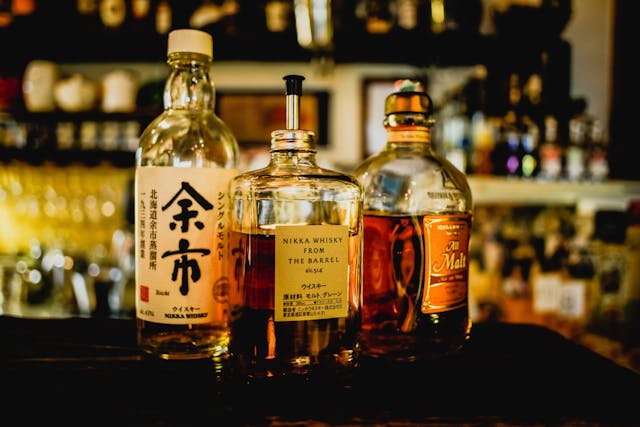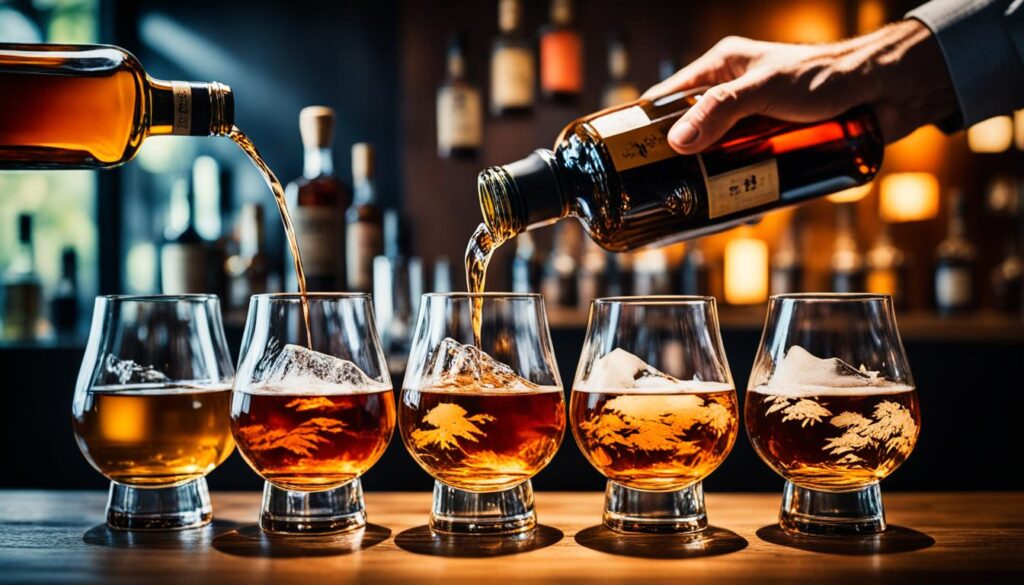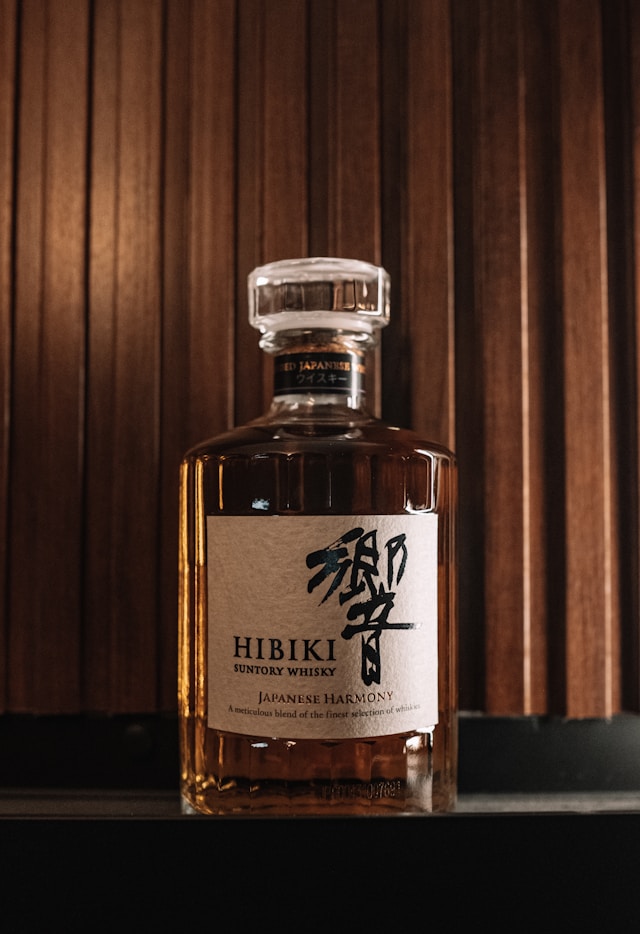Japanese whisky has gained international acclaim for its exceptional quality, craftsmanship, and unique flavor profiles. Japanese whisky has captivated the hearts of whisky enthusiasts around the world.
At its core, Japanese whisky embodies the essence of Japanese culture – meticulous attention to detail, impeccable craftsmanship, and respect for tradition.
People enjoy Japanese whisky not just neat or on the rocks but also in various cocktails. Mixologists appreciate its versatility and ability to elevate classic cocktail recipes. The smooth and well-rounded flavor profiles of Japanese whiskies blend seamlessly with other ingredients, creating unique and delightful concoctions.
As the demand for Japanese whisky continues to grow, distilleries are constantly innovating to meet the evolving tastes of whisky enthusiasts. They experiment with different cask finishes and incorporate local ingredients, ensuring that there is always something new and exciting to discover.
Pairing Japanese whisky with food is an art form in itself. The delicate flavors of Japanese cuisine, such as sushi, sashimi, and tempura, harmonize effortlessly with the smooth and nuanced characteristics of Japanese whisky. The interplay of flavors creates a memorable dining experience that heightens the enjoyment of both food and whisky.
Whether you’re a seasoned whisky connoisseur or just beginning your whisky journey, Japanese whisky offers a remarkable and captivating experience. From its rich history to its exquisite production process, Japanese whisky continues to push the boundaries of excellence and shape the future of the whisky industry.
Join us as we dive deeper into the fascinating world of Japanese whisky, exploring its history, production process, notable distilleries, popular brands, exciting trends, and innovative cocktails. Discover the allure of Japanese whisky and embark on a journey of taste and discovery.
Overview of the Japanese Whisky Market
The Japanese whisky market is experiencing significant growth, with a projected growth rate of 7.76% by 2028. This market provides valuable insights into market dynamics, growth determinants, and a competitive assessment. It segments into Single Malt Whiskies and Blended Whiskies, with applications in both commercial and residential sectors. Additionally, the unique flavor profiles and craftsmanship associated with Japanese whisky have gained international recognition, further fueling its growth.
As the market continues to grow, it is important to assess the competitive landscape. Major players in the Japanese whisky market include renowned distilleries such as Suntory Holdings Ltd and Nikka Whisky Distilling Co., Ltd. These industry leaders have established themselves as pillars of the Japanese whisky industry, producing high-quality and sought-after whisky expressions.
In assessing the market, it is crucial to consider the growth determinants that are shaping the Japanese whisky industry. Factors such as changing consumer preferences, global economic conditions, and the emergence of new whisky markets play a significant role in the future trajectory of this market.
To provide a comprehensive understanding of the market, let us examine the market segmentation in detail:
Segmentation of the Japanese Whisky Market
The Japanese whisky market have two main segments: Single Malt Whiskies and Blended Whiskies.
| Segment | Description | Key Players |
|---|---|---|
| Single Malt Whiskies | Whiskies made from malted barley in a single distillery. | Yamazaki, Hakushu, Yoichi |
| Blended Whiskies | Whiskies made by blending malt and grain whiskies from different distilleries. | Hibiki, Nikka Taketsuru, Chita |
The demand for both Single-Malt Whiskies and Blended Whiskies continues to grow, reflecting the diverse preferences of whisky drinkers. Connoisseurs favor single-malt whiskies, appreciating the distinct flavors and characteristics of whiskies produced in a single distillery. On the other hand, Blended Whiskies offer a harmonious blend of different flavors, delivering a balanced and approachable drinking experience.
The Japanese whisky market is an exciting and dynamic industry that presents opportunities for growth and exploration. As the market expands, it is crucial for industry players to stay competitive by continuously innovating and meeting the evolving demands of whisky enthusiasts worldwide.
History and Origins of Japanese Whisky
Japanese whisky has a rich history that dates back to 1923 when Masataka Taketsuru and Shinjiro Torri established the first commercial distillery, Yamazaki. Taketsuru, a passionate and knowledgeable whisky maker, had traveled to Scotland to learn the craft and brought his expertise back to Japan. This marked the beginning of Japanese whisky production and set the stage for its rise as a global sensation.
Today, Japan is home to approximately 24 distilleries, each offering its unique flavors and styles. The whisky produced in Japan has gained recognition and respect worldwide, with many distilleries winning prestigious awards for their exceptional craftsmanship.
Next, we will explore the growing demand for Japanese whisky and its impact on the global market.

Labeling Standards for Japanese Whisky
In an effort to regulate the production of Japanese whisky, new labeling standards have been established. These standards ensure the authenticity and quality of Japanese whisky and protect consumers from counterfeit products.
To label whisky as Japanese, producers must follow certain guidelines. These guidelines include:
- The use of malted grains: Japanese whisky must be made from malted grains, such as barley, corn, or rice.
- Extraction of water in Japan: Japanese whisky production requires the use of water sourced from Japan, enhancing the product’s authenticity.
- Distillation at a Japanese distillery: A licensed distillery in Japan is responsible for distilling Japanese whisky. This ensures that the production takes place within Japan.
- Maturation in wooden casks for at least three years: Japanese whisky must age in wooden casks, typically oak, for a minimum of three years. This maturation process gives the whisky its unique flavors and character.
- Bottling in Japan: The final stage of Japanese whisky production involves bottling the whisky in Japan.
With these labeling standards in place, consumers can confidently explore the world of Japanese whisky, knowing that they are enjoying the real deal. In the next section, we will delve into the fascinating history and origins of Japanese whisky.

Growing Demand for Japanese Whisky
The global market for Japanese whisky has witnessed a surge in demand, with the Asian market emerging as the largest consumer. Several factors contribute to this growing popularity, including the cocktail culture, experimental mixology, and rising income levels in countries such as India, Thailand, and China.
Japanese whisky has become synonymous with craftsmanship and excellence, captivating the taste buds of whisky enthusiasts around the world. The unique flavor profiles and meticulous production methods have made Japanese whiskies highly sought after among connoisseurs.
As the cocktail culture continues to evolve, bartenders and mixologists are increasingly incorporating Japanese whiskies into their creations. The versatility and complexity of these whiskies offer a wide range of possibilities for crafting unique and innovative cocktails.
Furthermore, the growing affluence in Asian countries has enabled consumers to embrace premium spirits like Japanese whisky. The desire for luxury and prestige has driven the demand for high-end offerings, contributing to the expansion of the global market size.
Emerging Markets in Asia
Among Asian markets, countries like India, Thailand, and China have witnessed a significant increase in the consumption of Japanese whisky. As these regions experience economic growth and cultural shifts, consumers are exploring and appreciating the flavors and craftsmanship of Japanese whisky.
In India, the demand for premium spirits has risen with the emergence of a thriving whisky culture. The growing number of whisky enthusiasts and the influence of international trends have fueled the demand for Japanese whiskies in the country.
Thailand, known for its vibrant nightlife, has seen a surge in the popularity of Japanese whisky. Trendy bars and speakeasies are showcasing an extensive selection of Japanese whiskies, attracting a diverse set of consumers.
China, with its expanding middle class and increasing disposable income, has emerged as a major market for luxury goods, including Japanese whiskies. The evolving preferences of Chinese consumers and their fascination with international brands have propelled the demand for Japanese whiskies in the country.
The growing demand for Japanese whisky in these Asian markets indicates a promising future for the global Japanese whisky industry. Consumers are developing a taste for Japanese whiskies, and the market is responding with further growth and expansion.

Awards and Recognition for Japanese Whisky
At the annual Japanese Whisky Awards, distilleries from all over Japan compete for top honors in various categories. These awards serve as a testament to the excellence and innovation embodied by Japanese whisky makers. The meticulous attention to detail and dedication to traditional production methods have earned Japanese whiskies a place among the best in the world.
Iconic Japanese whisky bottles have achieved remarkable success, attracting attention not just from connoisseurs but also from collectors and investors. Bottles such as the Yamazaki 18 Year Old and Karuizawa’s 52-Year-Old Zodiac Rat have fetched high prices at auctions, further cementing the international recognition and value of Japanese whisky.
| Whisky | Award | Year |
|---|---|---|
| Yamazaki 18 Year Old | World Whiskies Awards – Best Japanese Single Malt | 2021 |
| Karuizawa’s 52-Year-Old Zodiac Rat | Taiwan’s The Whisky Society – Gold Medal | 2020 |
| Hibiki 21 Year Old | International Spirits Challenge – Trophy | 2019 |
Price Surge and Scarcity of Japanese Whisky
The growing demand for Japanese whisky has led to price surges and scarcity of certain bottles. Whiskies that were once sold for lower prices have now become highly sought after, and their prices have significantly increased. Collectors and enthusiasts are willing to pay a premium for these rare bottles, driving up the market prices.
Limited availability also contributes to the scarcity of Japanese whisky. Some distilleries produce only a small quantity of certain expressions, making them highly exclusive. Additionally, the maturation process of Japanese whisky takes years, resulting in a limited supply of aged bottles. As a result, demand often exceeds supply, leading to increased prices and scarcity.
The scarcity of Japanese whisky has created a sense of urgency among enthusiasts, collectors, and investors. Due to their rarity, limited-release editions and single cask bottlings are particularly sought after. These highly coveted bottles attract attention not only for their exquisite taste but also as investment assets.
The scarcity and price surge of Japanese whisky has made it a valuable commodity in the spirits market. Whisky enthusiasts are constantly on the lookout for new releases and limited editions, hoping to add these prized bottles to their collections.
In the next section, we will explore the major players in the Japanese whisky market and their contributions to the industry.
Major Players in the Japanese Whisky Market
Two major players, Suntory Holdings Ltd and Nikka Whisky Distilling Co., Ltd., dominate the Japanese whisky market. These leading companies have established themselves as industry leaders and are known for producing some of the most acclaimed bottles of Japanese whisky.
Suntory Holdings Ltd, founded in 1899, is one of the oldest and most respected distilleries in Japan. The company produces a wide range of whisky brands, including Yamazaki, Hakushu, and Hibiki, which have gained international recognition and have won numerous awards for their exceptional quality and craftsmanship.
Nikka Whisky Distilling Co., Ltd, founded by Masataka Taketsuru, a pioneer of Japanese whisky, is another prominent player in the market. The company operates two distilleries, Yoichi and Miyagikyo, and offers a diverse portfolio of whiskies that showcase different styles and flavors. Nikka’s Taketsuru Pure Malt and Miyagikyo Single Malt have gained popularity among whisky enthusiasts worldwide.
These leading companies play a crucial role in shaping the Japanese whisky market and continue to innovate and push the boundaries of whisky production. With their rich heritage, commitment to quality, and dedication to the art of whisky making, Suntory and Nikka exemplify excellence in Japanese whisky manufacturing.
Regional Market Analysis of Japanese Whisky
The Japanese whisky market experiences varying levels of demand across different regions, with the Asia-Pacific region emerging as the largest market. Japanese whisky has also gained significant popularity in the United States, Europe, and the Philippines.
The Asia-Pacific region accounts for a substantial share of the Japanese whisky market, driven by the rising demand for premium spirits and the growing appreciation for Japanese whisky craftsmanship. Countries such as China, Japan, South Korea, and Australia have witnessed a surge in consumption, fueled by the increasing disposable incomes and the influence of Western cocktail culture.
The United States represents another key market for Japanese whisky. The appreciation for the smooth and complex flavors of Japanese whisky has led to a surge in demand among American consumers. The popularity of Japanese cuisine and the growing trend of whisky-tasting events have further contributed to the market growth in the United States.
Europe, particularly countries like the United Kingdom, Germany, and France, has also embraced the allure of Japanese whisky. Whisky enthusiasts and collectors in these regions recognize the exceptional quality and rich heritage associated with Japanese whisky. The European market presents promising opportunities for Japanese whisky manufacturers and brands.
Moreover, the Philippines has emerged as a noteworthy market for Japanese whisky, driven by the country’s strong whisky culture and growing interest in premium spirits. Filipino consumers have shown a preference for Japanese whisky due to its unique flavor profiles and exquisite craftsmanship.
As the global demand for Japanese whisky continues to grow, manufacturers and distributors are focusing their efforts on expanding their presence in these key markets. The Japanese whisky market caters to diverse preferences and builds strong distribution networks, positioning itself for continued success in Asia-Pacific, the United States, Europe, and other regions.
Impact of COVID-19 on the Japanese Whisky Market
The emergence of the COVID-19 pandemic has had a significant impact on the Japanese whisky market. Lockdowns, supply chain disruptions, and reduced consumer spending caused market turmoil. Countries are easing restrictions, leading to the expected market recovery through a fusion of pre-pandemic strategies and digital technology adoption.
The lockdown measures implemented globally resulted in the closure of bars, restaurants, and other hospitality establishments, leading to a decline in the consumption of Japanese whisky. This, coupled with supply chain disruptions that affected production and distribution, created a challenging environment for the market.
Nevertheless, as we enter a phase of recovery, the Japanese whisky market is adapting to the new normal. The industry is incorporating pre-pandemic marketing strategies with digital technology to reach consumers and regain momentum. Online platforms, virtual tastings, and e-commerce have become vital tools for whisky producers to connect with enthusiasts and expand their customer base.
The pandemic has also highlighted the importance of domestic demand. With international travel restrictions and a focus on supporting local businesses, the Japanese whisky market has pivoted to cater to its domestic consumers. Distilleries are exploring unique collaborations with local bars and retailers to create exclusive editions, fostering a sense of community and exclusivity.
The broader economic landscape and consumer behavior influence the recovery of the Japanese whisky market. Countries are implementing stimulus packages and easing restrictions, which will boost consumer spending. This, combined with the inherent appeal and quality of Japanese whisky, positions the market for a strong comeback.
In conclusion, while the Japanese whisky market experienced significant turmoil due to the COVID-19 pandemic, the industry is resilient and adapting to the evolving landscape. A combination of traditional marketing strategies, digital innovation, and the rediscovery of domestic demand will drive market recovery. In challenging times, the Japanese whisky market positions itself to emerge stronger and continue its growth trajectory.
Future Directions for the Japanese Whisky Market
The global spirits industry presents challenges and opportunities for growth and innovation in the Japanese whisky market. With evolving technology, shifting user behaviors, and emerging trends, it is crucial for industry players to stay ahead of the curve, adapt to new consumer preferences, and anticipate future market dynamics.
One of the key future trends in the Japanese whisky market is the integration of technology. From advanced production techniques to smart packaging, technology is revolutionizing the way whisky is made and consumed. Distilleries are embracing automation and artificial intelligence to enhance consistency and quality, while interactive packaging and augmented reality experiences are captivating consumers and enhancing their whisky-drinking journey.
User behavior is another significant factor shaping the future of the Japanese whisky market. As consumers increasingly seek authentic and unique experiences, distilleries are exploring creative ways to engage and connect with their audience. Personalized tasting sessions and whisky appreciation events focus on creating immersive experiences that cater to individual preferences and foster brand loyalty.
Lastly, trends such as sustainable practices and craft distilling will play pivotal roles in defining the future of the Japanese whisky market. With a greater emphasis on environmental consciousness, distilleries are adopting sustainable production practices and promoting transparency. Craft distillers, focusing on artisanal production and small-batch releases, add diversity and innovation to the market.
Hungry for more whisky knowledge? Check out our extensive collection of articles on whisky trends and insights. Visit the Scotland Whisky Blog and expand your whisky expertise today!